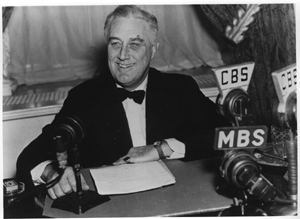![]()
POLITICAL RADIO
SELECTED
BIBLIOGRAPHY
Allan Louden, Wake Forest University (louden@wfu.edu)
3Last Updated: Sunday, 21-Sep-2008 12:33:41 EDT

Airoldi, E. M., Fienberg, S. E., & Skinner, K. K. (2007). Whose ideas? Whose words? Authorship of Ronald Reagan's radio addresses. PS: Political Science & Politics, 40, 501-506.
Albert, J. A. (198?). The remedies available to candidates who are defamed by television or radio commercials of opponents. Vermont Law Review, 11, 33-73.
Barker, D., & Knight, K. (2000). Political talk radio and public opinion. Public Opinion Quarterly, 64, 149-170.
Barker, D. C. (1998). Rust to action: Political talk radio and health care (un)reform. Political Communication, 15, 83-97.
Bennett, S. E. (2002). Predicting Americans' exposure to political talk radio in 1996, 1998, and 2000.Harvard International Journal of Press/Politics, 7, 9-22.
Bennett. S. E. (2001). American' exposure to political talk radio and their knowledge of public affairs. Journal of Broadcasting& Electronic Media, 45, 72-86.
Bennett, S. E. (1998). Political talk radio shows' impact on democratic citizenship. In T. J. Johnson, C. E. Hayes, & S. P. Hayes (Eds.), Engaging the public: How government and the media can reinvigorate American democracy (pp.111-121). Lanham, MD: Rowman & Littlefield Publishers.
Cappella, J., Turow, J., & Jamieson, K. (1996). Call-in political talk radio: Background, content, audiences, portrayal in mainstream media. The Annenberg Public Policy Center of the University of Pennsylvania.
Cohen, A. (1976). Radio vs. TV: The effect of the medium. Journal of Communication, 26, 29-35.
Davis, R. (1997). Understanding broadcast political talk. Political Communication, 14, 323-332.
Davis, R., & Owen, D. (1997). The media in American politics. Boulder, CO: Westwood. (materials on talk shows, tabloid, etc.)
Foote, J. S. (1984). Reagan on Radio. In R. N. Bostrom (Ed.), Communication Yearbook 8 (pp. 692-706). Beverly Hills, CA: Sage.
Geer, J. G., & Geer, J. H. (2003). Remembering attack ads: An experimental investigation of radio. Political Behavior, 25, 68-95.
Han, L. C. (2006). New Strategies for an Old Medium: The Weekly Radio Addresses of Reagan and Clinton. Congress & the Presidency, 33, 25-45.
Hoffstetter, C. R., Donovan, M. C., Klauber, M. R., Cole, A., Huie, C. J., & Yuasa, T. (1994). Political talk radio: A stereotype reconsidered. Political Research Quarterly, 47, 467-479.
Hoffstetter, C. R. , & Gianos, C. L, (1997). Political talk radio: Actions speak louder than words. Journal of Broadcasting and Electronic Media, 24, 501-515.
Hollander, B. A. (1997). Fuel to the fire: Talk radio and the Gamson Hypothesis. Political Communication, 14, 355-369.
Jones, D. A. (1998). Political talk radio: The Limbaugh effect on primary voters. Political Communication, 15, 367-381.
Lee, G., & Cappella, J. N. (2001). The effects of political talk radio on political attitude formation: Exposure versus knowledge. Political Communication, 18, 369-394.
Martin, H. H. (1984). President Reagan's return to Radio. Journalism Quarterly, 61, 817-821.
McCleneghan, J. S. (1987). Impact of radio ads on New Mexico mayoral races. Journalism Quarterly, 64, 590-593.
Overby, L. M., & Barth, J. (2006). Radio advertising in American political campaigns: The persistence, importance, and effects of narrowcasting. American Politics Research, 34, 451 - 478.
Page, B. I., & Tannenbaum, J. (1996). Populistic deliberation and talk radio. Journal of Communication, 46, 33-54.
Panagopoulos, C., Green, D. P. (2008). Field experiments testing the impact of radio advertisements on electoral competition. American Journal of Political Science, 52, 156–168.
Patterson, T. E. (1983). Money rather than TV ads judged "root cause" of election costliness. Television/Radio Age, 44, 130-132.
Reinsch, J. L. (199?). Getting elected: From radio and Roosevelt to television and Reagan. Hippocrene Books.
Rudd, R. (1989). Effects of issue specificity, ambiguity on evaluations of candidate image. [Radio spots] Journalism Quarterly, 66, 675-682, 691.
Schwartz, T. (1987). Radio advertising in campaigns. In L. P. Devlin (Ed.), Political persuasion in presidential campaigns, (pp. 63-73). New Brunswick: Transactional Books.
Shapiro, M. A., and Riege, R. H. (1992). Comparing positive and negative political advertising on Radio. Journalism Quarterly, 69, 135–145.
Siegelman, L., & Whissell, C. (2002). Projecting presidential personas on the radio: An addendum on the Bushes. Presidential Studies Quarterly, 32, 572-576.
Wasburn, P. C. (1992). Broadcasting propaganda: International radio broadcasting and the construction of political reality. Westport, CT: Praeger.
Wood, A., & Adams, T. L. (1997). Making sense of the 1994 right-wing revolution in the United States: How the Christian right, the Grand Old Political Action Committee (GOPAC), and talk radio collaborated. Speaker and Gavel, 34, 51-63.